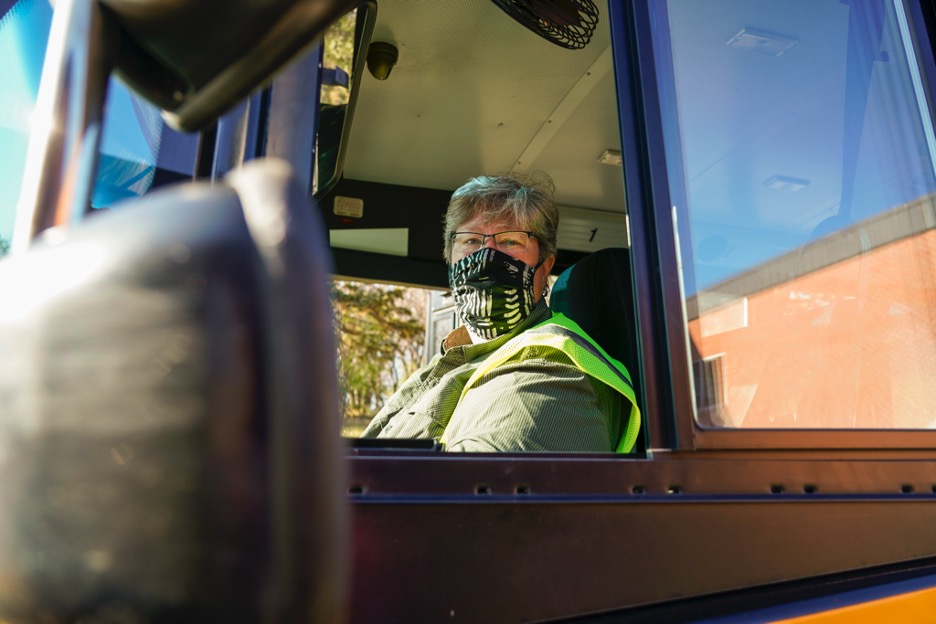One day last spring, Naima Kaidi waited nearly an hour for her kindergartener and first-grader to get home from school. She stood on the corner near her house, but the bus was nowhere to be seen and there was no word why it was so late. Northport Elementary in Brooklyn Center, Minnesota, had only recently reopened for in-person classes, and day after day, Kaidi’s family had been struggling with late school bus drop-offs. This day was the worst. Cold and worried, she eventually carried her younger children back home to get her phone and try to find out what was going on — and that was when she got a knock on the door.
It was Roberta Steele, who had driven the school bus in Kaidi’s neighborhood for years, there to bring the two children home. Steele knew where the kids on her route lived. She knew who their parents were. And even though it wasn’t her fault that the bus was late, Steele made sure the kids arrived home safely. “She helped me, she [brought] my kids over here,” Kaidi said. Even if the bus system wasn’t reliable, the driver was.
But that was last school year. Even then there was already a shortage of bus drivers in the district. Steele said that had been the case for years, though district representatives were quick to point out that there had never been a shortage of this magnitude. This fall, the shortage became dire enough that Steele’s old route — the one where she knew all the kids well enough to take them to their doorsteps when needed — was consolidated out of existence. In October, the district told parents that 12 routes probably wouldn’t be staffed this year. Steele was transferred to a different route with new kids, and sometimes the chaos of route changes and late buses meant she also had to drive kids home from other, equally unfamiliar routes.
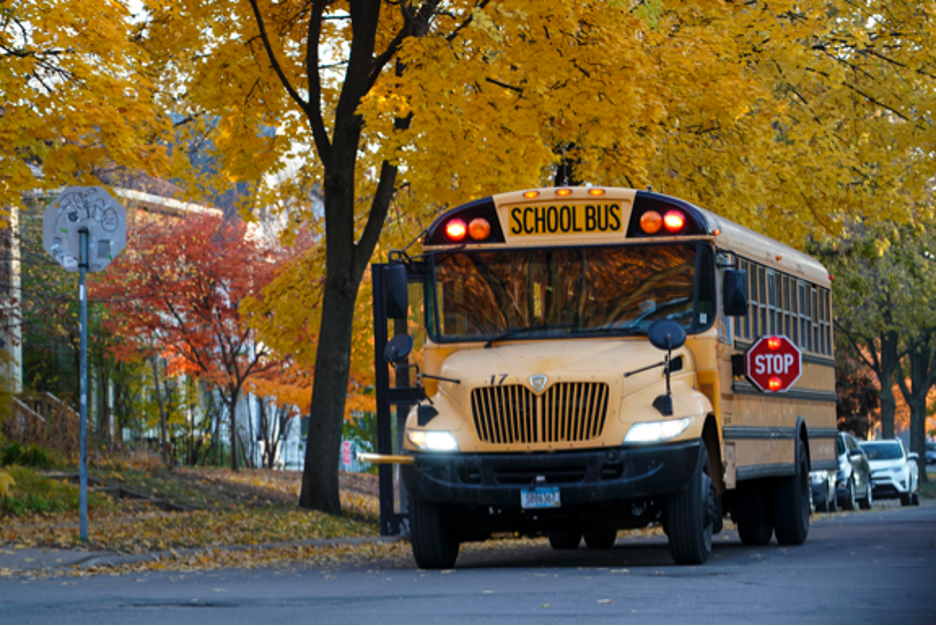
It isn’t an easy job. The kids don’t behave. Some, unsure of their own addresses, can’t tell Steele where to go. When parents get angry at a system that isn’t working, they blame Steele. And the company that runs the buses has packed her schedule to the point that there’s no longer time left to pee between runs. She’s thinking of quitting, even though she knows that will make things even harder for the families relying on her.
Meanwhile, Kaidi’s family spent the first two months of school with no bus at all. Instead of waiting at her corner with other parents, she spent her afternoons sitting in her car in the pickup line outside school. The line backed up for blocks, 40 or 50 cars deep, threading out of the parking lot and down an undulating suburban road. Kaidi had to get there an hour before school ended just to make sure she was near the front. She says she turned down a job so she could do this. Likewise, other parents had to change their hours, lose pay and go without sleep — all to sit in their cars, waiting for their children.
As the bus driver shortage continues, parents and drivers, often women on both sides, have been stretched to the breaking point as they try to do more with less — less time, less money, less help, less of a sense of safety and respect. “This problem existed before COVID, but nobody wanted to hear about it, especially the school districts,” said Zina Ronca, a driver supervisor for DuVall Bus Service in West Grove, Pennsylvania, who has been in the industry for nearly two decades. There haven’t been enough school bus drivers nationwide for years. But it took a pandemic to make that shortage visible and painful to more than just the drivers themselves.
And in that way, what’s happening at Northport Elementary reflects an even bigger problem for schools nationwide. Across the country, reports have documented shortages of substitute teachers, school nurses, cafeteria workers and the paraprofessionals who help teachers manage their workloads and give kids more small-group attention. As with drivers, those shortages existed before anyone had ever heard of COVID-19. The problems were there, waiting, and then the pandemic came along and made them simultaneously more visible and more … just more.
All these jobs are about service and care, at pay scales that simply aren’t competitive with jobs that use similar skills but don’t require child care balanced precariously on top of other demands. And when the people who do those jobs quit, the effects get tangled up with other parts of the economy and other parts of society. Amid the pandemic, individual workers are making choices for themselves and their families that affect other people’s families and jobs in ways nobody quite expected. The bus driver shortage isn’t just a bus driver shortage — it’s a knot nobody knows how to cut.
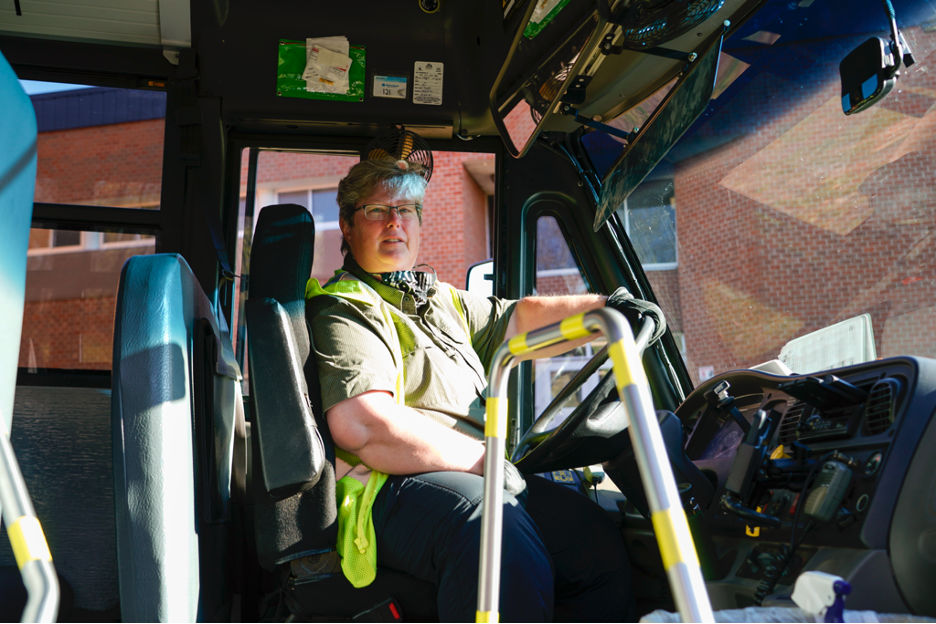
When I pictured the village of people who would help me raise my children, the person driving them to and from school didn’t come immediately to mind. But in the third year of school disruption, it turns out that the bus driver is a person in your neighborhood whom you miss when you don’t see them every day. The job involves only a minimal amount of interaction, Roberta Steele told me. But it’s daily interaction. “You know you’re making a difference for some kids, and that brings me great joy,” she said. “I have kids that I had in middle school that are now in high school. And they will walk from the high school to the middle school just to say hi.”
Steele, 50, is a barrel-chested woman with cropped, spiky hair the color of her last name. She comes off as perky and outgoing, basically the vibe of a favorite grade-school gym teacher. She doesn’t have kids of her own but places a lot of value in the role she can play in the lives of other people’s.
Steele has been driving a school bus since 2014, all of it for Robbinsdale School District 281, one of those sprawling suburban districts that encompass schools and children in multiple cities on the fringes of Minneapolis. She took the job after leaving the Minneapolis Police Reserve but almost quit in the first two years. The kids were just a lot. A typical school bus can carry 70 children when full. They get bored, or they just plain don’t know how to behave. “I resorted to bribery as a method of training,” she told me, using small treats to manage the threat of prepubescent uprisings.
Today, she can quell most bad behavior with a look delivered through the rearview mirror. Her starting pay, driving a 15-ton vehicle down the winding, narrow roads of inner-ring suburbs while managing the behavior of a small village worth of kids, and for which she needed to take classes and earn a special license, was $14 an hour. “It’s really rewarding, or it can be, if you like children, right?” Steele said.
But not everyone does. Or, at least, not at that price point. Steele’s entire bus driving career has been marked by not having enough colleagues. She told me she found the job in the first place because the district was recruiting heavily to fill a shortage, though representatives from the district stressed that they had never had a shortage like this before. Nationwide, more than 50 percent of districts have experienced a shortage of drivers every year since at least 2006, according to annual surveys conducted by School Bus Fleet magazine. Most years, the driver shortage affected more than 70 percent of districts. The lowest the shortage has been in all that time was in the depths of the Great Recession.
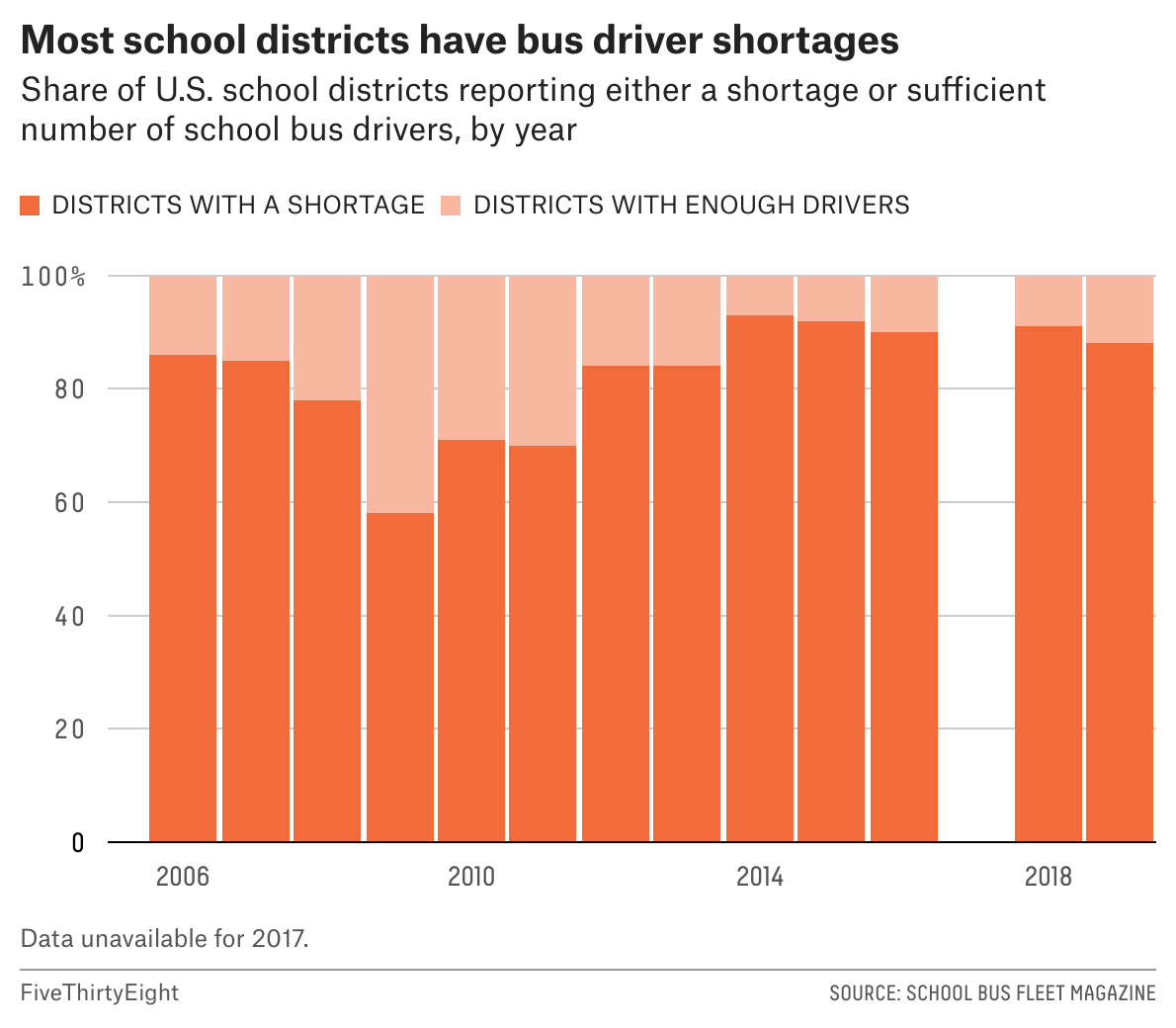
Over the years, as shortages continued, Steele’s pay did increase. Today, after a big post-COVID pay raise, she’s making $23.75 per hour, well above the nationwide average starting pay for school bus drivers, $18.82 per hour according to a 2021 survey.
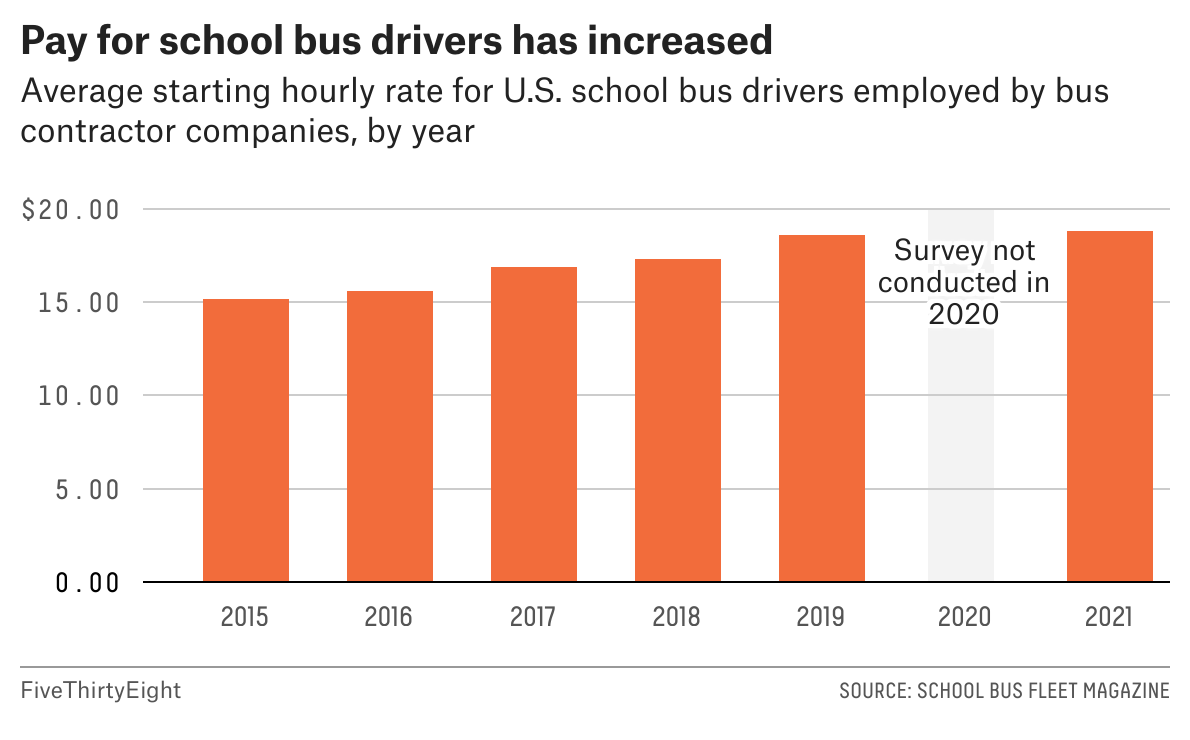
At year-round, full-time hours — the way the U.S. Bureau of Labor Statistics calculates an annual wage — the average school bus driver makes more than $39,000 a year. But school bus drivers don’t work year-round, full-time hours. “We’re only guaranteed four hours of pay a day,” Steele said.
There are no paid holidays or sick days, she and other bus industry experts say. Benefits vary from company to company, and there’s no guaranteed work at all in summer. “Spring break is all unpaid. Every teacher-compensatory day, every snow day, any time they cannot pay us they will,” Steele said. She added that a recent, failed unionization effort among the Robbinsdale bus drivers started in part as a fight for snow-day pay.
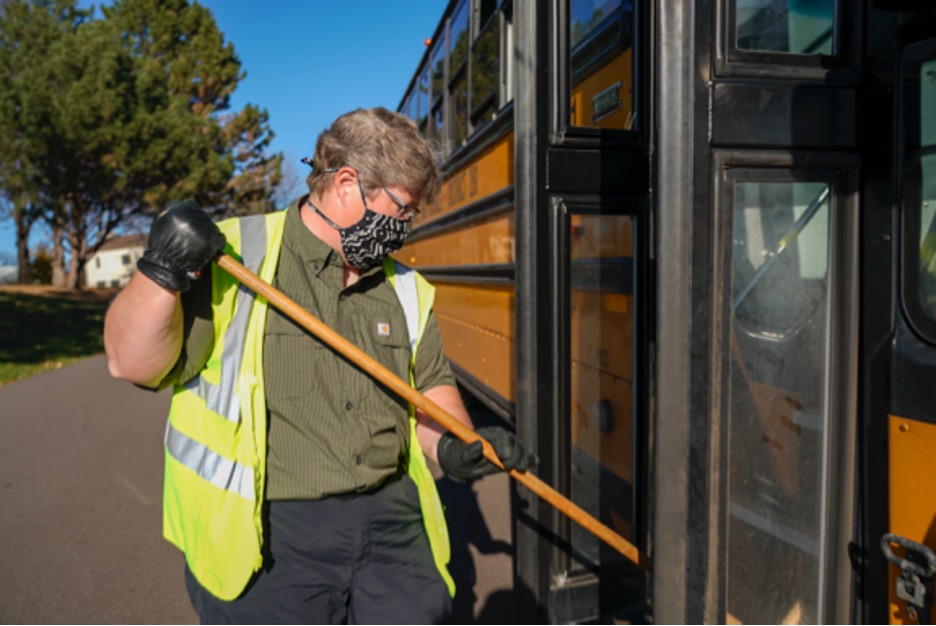
Working as a school bus driver means, essentially, needing another source of income. This is part of why the job has long attracted women — particularly mothers — who were able to work while their children were at school. In 2020, the Bureau of Labor Statistics reported that 58.5 percent of all school bus drivers were women. The hours are predictable and short, with a gap in the middle of the day when your time is your own, during which some drivers earn money doing other jobs, like working as a mechanic for the bus company, or doing a different caregiving job in schools. And the job comes with unusual perks like the ability to take the bus home, turning the morning commute into a walk to the driveway. At some bus companies and school districts, drivers have the freedom to take their young children on the bus with them during their rounds — a chance to bring in money without adding to the ever-rising cost of day care.
But it doesn’t pay enough to live on. For Steele, the job works only because her partner brings in a paycheck and benefits. Other drivers depend on a second job, performed between roughly 9 a.m. and 1:30 p.m., when they aren’t on the clock. LaShawn Favors, a bus driver in the Minneapolis suburb of St. Louis Park, had a second part-time job as a paraprofessional in a school while his wife worked from home in the health-care industry. His route didn’t overlap with where his own kids, who lacked reliable bus service, needed to go, so his wife and his daughter’s boyfriend were stuck shuttling the kids to and from school while Favors rushed from one job to another and back to the first.
Drivers spackle their work lives together this way, with voluntary overtime and luck, and they still struggle. COVID didn’t make the job hard, it just made it harder.
Survey: Are you currently a K–12 teacher? FiveThirtyEight and The Fuller Project would love to hear from you.
Pay is the problem, and COVID made it worse by threatening the unique benefits that kept people driving buses, despite the low pay, to begin with. Older drivers suddenly had to deal with the increased risk of sickness and death, risks that haven’t really been properly calculated anywhere. No one knows how many bus drivers are no longer in their jobs because they died from COVID-19 infections acquired on the job, because no one is keeping track.
Other drivers had no real choice but to find other work during the long months when schools were remote and had no need of them, while drivers who were mothers found themselves trying to juggle home and work in a job they’d taken precisely so they wouldn’t have to do this in the first place. When schools moved to hybrid systems, the districts needed drivers every day, but those drivers’ own kids’ schedules may not have been in sync, said Erin Ducharme, vice chair of membership for the Women in Buses Council and an executive at Bloom Tour and Charter Services in Taunton, Massachusetts.
Schools are filled with essential workers whose difficult jobs were made even harder, and their ranks even thinner, by the pandemic. School nurses, for instance, have also been in short supply for years, even more so amid the pandemic. Like drivers, school nurses are most likely to be women, and they earn far less than what they could get if they took their skills and training elsewhere — as little as $58,810 in median annual wages compared with more than $75,000 if they worked in a hospital.
Nationwide, there have been reports of shortages of cafeteria workers, custodians, substitute teachers and paraprofessionals. According to a survey conducted by EdWeek Research Center in late September and early October, 40 percent of district leaders and principals said they were experiencing “severe” or “very severe” staffing shortages. The bus driver shortage is part of a larger, longer problem in schools — one that extends beyond the school building. When “women’s jobs” go unfilled, other women, namely moms, pick up the slack — and the effects reverberate across the economy.
Caregiving is interconnected. Roberta Steele doesn’t just drive a bus. She drove a bus to pick up and drop off Naima Kaidi’s children. Without Steele’s services, Kaidi still had to get the kids to school. But the task became harder and required her to make more sacrifices.
Parents like Kaidi depend on the services of bus drivers, nurses, lunch ladies and subs. Statistically, the parents who depend on those services the most are moms — they still do more of the parenting labor, and their own jobs become more disrupted when there aren’t other women doing the outsourced work for things like transportation or food preparation. A 2019 Pew Research Center survey of adults in opposite-sex relationships found that 59 percent of women reported handling more of the household chores and responsibilities than their partners, and among those with children under 18 at home, 78 percent of women reported doing more work to manage their children’s activities and schedules. Working mothers were more likely than working fathers to report having to reduce work hours to deal with household or family needs. And during the pandemic, women were twice as likely as men to say they had to juggle “a lot” of parenting duties while simultaneously teleworking.
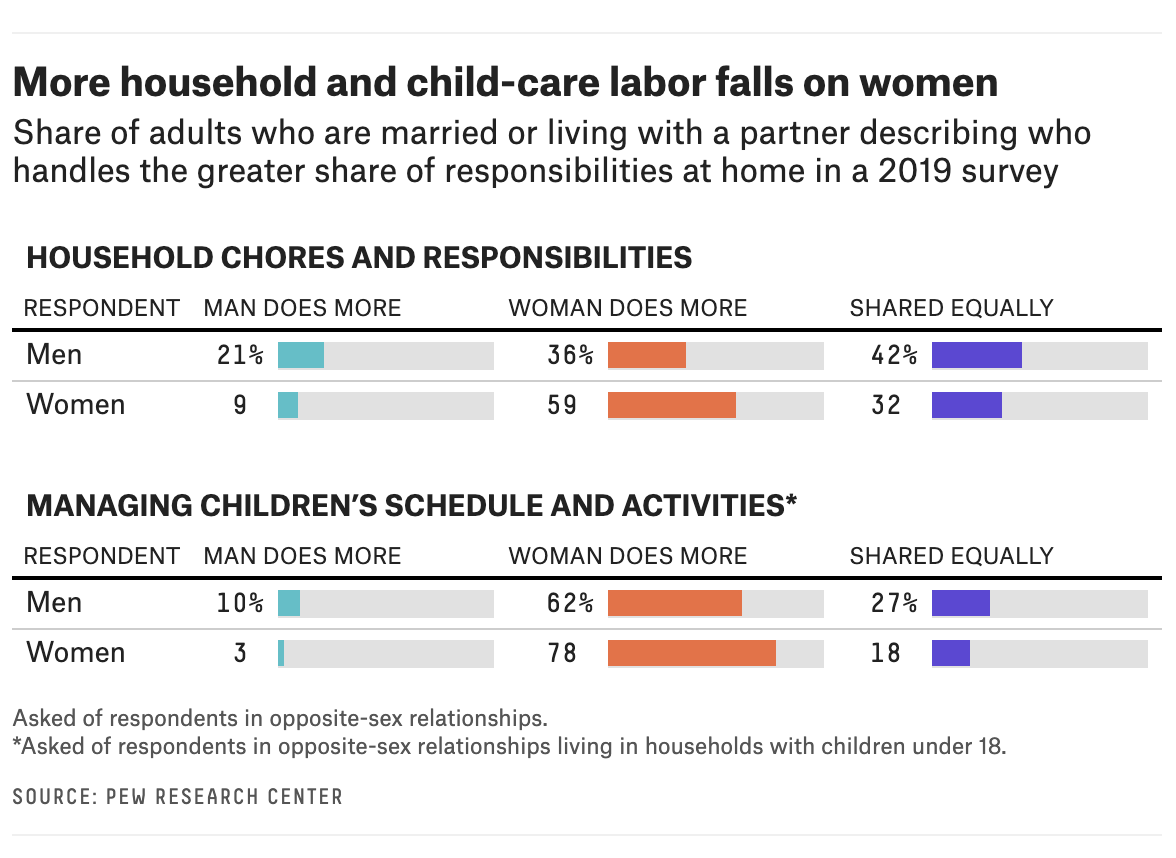
Low-paid caregiving jobs bind together a lot of big trends happening in the economy, said Abigail Wozniak, a labor economist at the Minneapolis Federal Reserve. And you can see those themes play out in the lives of the women whose children used to ride to school on Roberta Steele’s bus — and now have no bus service at all.
Take Amanda Swanson, a neighbor of Kaidi’s, who spent the first months of school making a point of being first in the hour-long pickup line every day at Northport Elementary. She’s supporting her family working as a manager at an Amazon fulfillment center while her husband stays home with their youngest children because child care is too expensive. He used to be able to walk the children to the bus stop. But after the bus stopped running, Swanson switched to an overnight shift and frequently left her job early so she could drive them in the family’s only car.
Not long ago, Swanson (or her husband) would have been a prime candidate to be a school bus driver. Instead, she’s working a job that didn’t exist a decade ago but pays enough to keep her family solvent. It’s not just that school-support jobs don’t pay enough, it’s that they’re in direct competition for workers with jobs that pay more.
“At least since the 1970s, wages for the majority of Americans have barely budged, and if anything they’ve decreased for workers that don’t have a college degree,” said Krista Ruffini, a professor of economics at Georgetown University. Even before COVID-19, that squeeze is part of what has made jobs like bus driving less attractive today than they were 20 or 30 years ago, and it’s also put those jobs in competition with newer kinds of work — gig-economy jobs or delivery and warehouse jobs that require the same kinds of skills, pay the same or more, and require less emotional labor, Wozniak said.
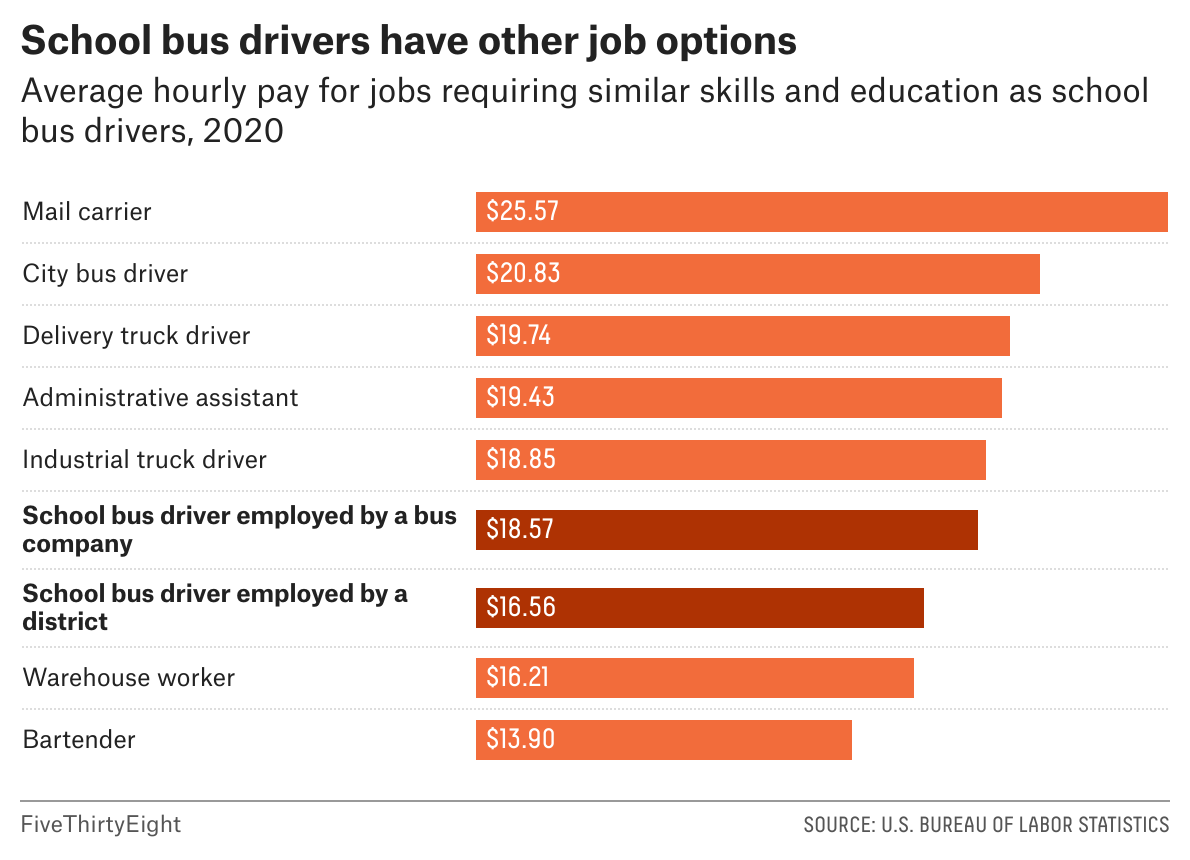
So far, these newer jobs are still a relatively small portion of all jobs and because of that probably can’t explain big, economy-wide trends. “But there will be some employers now who are competing with, basically, Amazon,” she said. A school bus driver could instead drive a delivery vehicle. School support staff like paraprofessionals and lunch ladies have logistics skills that are needed in a warehouse.
And when there’s a shortage of school bus drivers, that makes it hard for some parents to take a job. Once her children were finally old enough to be in school during the day, Kaidi had intended to go back to work this fall for the first time in years. But, she said, she’s received multiple job offers she couldn’t accept because of the time she has to spend ferrying her children to and from four different school buildings.
Her conundrum makes it easy to understand how the pandemic has disproportionately affected women’s careers. “On the female side of the labor market, we know that there’s been an increase in people that say that they can’t work because they’re providing care,” Ruffini said. Some have had to quit; others just don’t reenter the workforce, even when they have an opportunity. That’s been a feature of the pandemic, affecting a wide swath of the kinds of service and emotional-labor jobs that disproportionately employ women — jobs like the ones in schools. Kaidi’s experience shows how shortages in one field can create or exacerbate shortages in another.
Meanwhile, many of the women who have stayed in their emotional-labor jobs are being pushed to a breaking point — women like Swanson and Kaidi’s neighbor Christiana Metzger, a nursing assistant who works nights and has been running on almost no sleep since the beginning of the school year in September. She described breaking the speed limit, exhausted, trying to get home fast enough to take her older children to class on time, preparing meals and picking kids up from school and checking their homework, and the headache she’d had for several days straight.
The jobs done by people like Metzger are what middle-level jobs look like today, said Nicole Smith, chief economist at the Georgetown University Center on Education and the Workforce. Along with the lack of growth in real wages, there’s the idea that the job spectrum has hollowed out, leaving nothing but the worst-paying jobs and the ones that pay well but require college degrees. But that’s not exactly the case, Smith says. There are jobs left in the middle, but they’re no longer in manufacturing — they’re jobs that involve caring for people (like nurses) or supporting other workers (like school paraprofessionals). Again, women’s jobs. Jobs that continually conflict with women’s labor at home.
The emotional and psychological aspects of work are something economists are only just beginning to pay attention to, Wozniak said. But when shortages happen — whether through the cost-saving design of a lean staffing model or a chain of unfortunate events — it’s those intangible, immeasurable parts of a job that can quickly spiral out of control. “Now there are three people in the lunchroom instead of five or eight,” she said. “It’s the same job but not at all the same because you’re doing it faster and with less help.”
The bus driver shortage is a pay issue, but it’s also clearly more than that. It’s about how your job treats you. It’s about what you’re expected to do outside of the office. It’s about the narrow space women are squeezed into where we need to be better paid for the hard work we do at caregiving jobs but also need other women to do caregiving jobs at a lower price we can afford. It’s about being forced to make a choice between fulfilling your responsibilities at work and getting your children home safely. And it’s about how schools do, and don’t, function.
At the end of October, Kaidi, Metzger and Swanson finally got bus service again. But they didn’t get it from Steele, who remains relegated to a different route, increasingly unhappy with the way the bus company and the district are treating her and other drivers. The immediate crisis ended for some of the moms of Brooklyn Center. But the problem isn’t solved. Not for the drivers. Not for the school districts suffering disruption on top of disruption. And not for the nation as a whole. “What’s going on in the labor market is something that we certainly haven’t seen in my lifetime,” Ruffini said. People have been out of work and out of their normal routines for a long time, she noted. Their responsibilities have changed at home. And so have the ways they spend their time and their resources. Nobody knows what happens next.
But we do know that what happens with bus drivers is going to affect what happens with a lot of other people. The pandemic didn’t create these shortages. But it made clear how inextricably linked one job is to a whole bunch of others — how our lives and livelihoods are lashed together with cords we can’t usually see. When a time of stress and tragedy makes those invisible bonds more tangible, we can’t go back to pretending they don’t exist. All we can do is try to untangle them together.
This story was published in collaboration with FiveThirtyEight and The Fuller Project.


 Maggie Koerth
Maggie Koerth